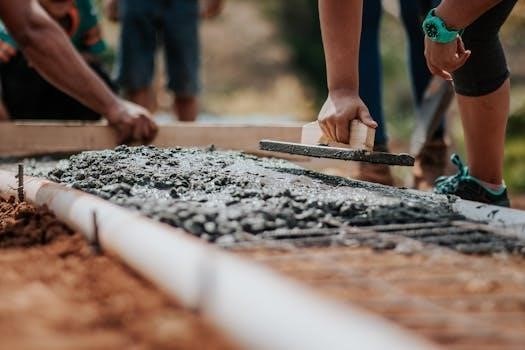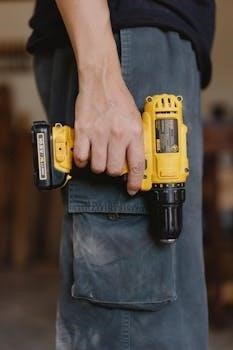GE Adora Refrigerator Manual⁚ A Comprehensive Guide

Welcome! This guide offers an overview of the GE Adora refrigerator manual. We’ll explore how to use it effectively, covering finding your model’s manual to troubleshooting tips for optimal performance.
Finding the Right Manual for Your Model
Locating the correct manual for your GE Adora refrigerator is crucial for effective use and maintenance. GE Adora offers a variety of refrigerator models, including side-by-side, French-door, and bottom-freezer configurations, each with unique features and specific instructions. The first step is to identify your refrigerator’s model number. This is typically found on a label inside the refrigerator compartment, often on the side wall or near the top. Once you have the model number, you can search for the corresponding manual on the GE Appliances website. The website offers a comprehensive library of owner’s manuals, installation instructions, and service manuals.
Alternatively, you can use online search engines to find the manual. Simply enter “GE Adora refrigerator manual” followed by your specific model number. This will often lead you to a downloadable PDF version of the manual. Several websites specialize in hosting appliance manuals, making it easier to find the exact document you need. Ensure that the manual you download is specifically for your model to avoid incorrect information. If you have difficulty finding the manual online, you can contact GE Appliances directly through their customer support channels; They can provide you with a digital copy or guide you to the correct resource. Having the right manual ensures you have access to accurate information about your refrigerator’s operation, care, and troubleshooting, helping you maintain its performance and longevity.
Understanding the Owner’s Manual
The owner’s manual for your GE Adora refrigerator is an indispensable resource for ensuring its proper operation and longevity. This document provides detailed information on various aspects of your appliance, from initial setup to troubleshooting common issues. Familiarizing yourself with the manual’s contents is crucial for maximizing the refrigerator’s performance and avoiding potential problems; The manual typically begins with essential safety instructions, which should be read carefully before using the refrigerator. These instructions cover potential hazards and precautions to prevent accidents or damage.
Next, the manual outlines the refrigerator’s features and components, including adjustable shelves, door bins, and freezer compartments. Understanding how these elements are designed to function helps you organize your food efficiently and optimize storage space. Operating instructions provide step-by-step guidance on setting the temperature, using the ice maker (if applicable), and activating special features like quick freeze or vacation mode. The manual also includes detailed cleaning instructions, recommending appropriate cleaning agents and methods for maintaining the refrigerator’s interior and exterior. Regular cleaning not only keeps your food fresh but also prevents the buildup of mold and odors.
Troubleshooting tips are another valuable section of the owner’s manual. This section addresses common issues such as unusual noises, temperature fluctuations, and ice maker malfunctions. By following the troubleshooting steps, you may be able to resolve minor problems yourself, saving time and money on service calls. Finally, the manual provides information on warranty coverage and how to contact customer support for further assistance. Keeping the owner’s manual in a safe and accessible place ensures you can quickly reference it whenever needed, making it an essential tool for the successful operation and maintenance of your GE Adora refrigerator.
Installation Instructions
Proper installation is paramount to ensure your GE Adora refrigerator operates efficiently and safely. The installation instructions provided in the owner’s manual are your primary guide, offering step-by-step directions for setting up your new appliance. Before you begin, carefully inspect the refrigerator for any shipping damage. If you notice any dents, scratches, or other signs of damage, contact the retailer or manufacturer immediately. Ensure you have all the necessary tools and materials, such as a screwdriver, level, and possibly a wrench for connecting the water line if your model has an ice maker or water dispenser.
The first step typically involves choosing a suitable location for your refrigerator. The area should be level, sturdy, and capable of supporting the refrigerator’s weight when fully loaded. Avoid placing the refrigerator near heat sources, such as ovens or direct sunlight, as this can affect its cooling performance. Ensure there is adequate ventilation around the refrigerator, typically a few inches of clearance on all sides and the top, to allow for proper airflow and heat dissipation. Once you’ve selected the location, carefully move the refrigerator into place. Use caution to avoid scratching the floor or damaging the refrigerator’s exterior.
Next, level the refrigerator by adjusting the leveling feet at the bottom. Use a level to ensure the refrigerator is perfectly horizontal. Leveling prevents the doors from swinging open or closed on their own and ensures the refrigerator operates efficiently. If your model has an ice maker or water dispenser, you’ll need to connect it to a water supply. Follow the instructions in the manual for connecting the water line, ensuring all connections are tight and leak-free. Once the water line is connected, turn on the water supply and check for any leaks. Finally, plug the refrigerator into a grounded electrical outlet. Allow the refrigerator to run for several hours to reach its optimal cooling temperature before loading it with food. By following these installation instructions carefully, you can ensure your GE Adora refrigerator is set up correctly and ready to provide years of reliable service.
Operating Instructions
Understanding the operating instructions for your GE Adora refrigerator is crucial for maximizing its performance and lifespan. Your owner’s manual is your best resource, detailing the specific features and controls of your model. Familiarize yourself with the temperature settings for both the refrigerator and freezer compartments. The recommended temperature for the refrigerator is typically between 34°F and 40°F (1°C and 4°C), while the freezer should be set at 0°F (-18°C) for optimal food preservation. Adjust the temperature settings according to your needs, considering factors like the amount of food stored and the ambient room temperature. Most GE Adora refrigerators have adjustable shelves and door bins, allowing you to customize the interior layout to accommodate different sizes and shapes of food items.
Take advantage of these features to organize your food efficiently, placing frequently used items within easy reach. If your refrigerator has a water dispenser and ice maker, understand how to operate these features properly. Ensure the water filter is replaced regularly, as recommended in the manual, to maintain water quality. The ice maker usually has an on/off switch, allowing you to conserve energy when ice is not needed. Some models also have advanced features like Turbo Cool or Quick Freeze, which rapidly cool the refrigerator or freezer compartment. Use these features when loading large quantities of food or when you need to chill items quickly.
Pay attention to any indicator lights or error messages displayed on the control panel. These messages can provide valuable information about the refrigerator’s status and alert you to potential problems. For example, a “door ajar” warning indicates that the door is not closed properly, which can lead to temperature fluctuations and wasted energy. By understanding and following the operating instructions in your GE Adora refrigerator manual, you can ensure your appliance operates efficiently, keeps your food fresh, and provides years of reliable service. Regularly consulting the manual will also help you troubleshoot any minor issues and prevent them from escalating into major problems. Remember, proper operation contributes significantly to the longevity and performance of your refrigerator.

Care and Cleaning
Proper care and cleaning are essential for maintaining the performance and appearance of your GE Adora refrigerator. Regular cleaning not only keeps your refrigerator looking its best but also helps prevent odors and bacteria growth, ensuring your food stays fresh. Before you begin any cleaning, always unplug the refrigerator to avoid electrical shock. Refer to your owner’s manual for specific cleaning recommendations for your model, as some components may require special care. Start by removing all food items from the refrigerator, checking for any expired or spoiled products. This is a good opportunity to wipe down shelves and drawers with a mild detergent and warm water solution. Avoid using abrasive cleaners, scouring pads, or harsh chemicals, as these can damage the surfaces of your refrigerator.
For stubborn stains or spills, a mixture of baking soda and water can be effective. Simply make a paste and apply it to the affected area, let it sit for a few minutes, and then wipe it away with a damp cloth. Pay attention to the door seals, as these can accumulate dirt and grime over time. Clean the seals with a soft cloth and mild detergent to ensure a tight seal, which helps maintain the proper temperature inside the refrigerator. The exterior of your refrigerator can be cleaned with a damp cloth and a mild appliance cleaner. For stainless steel models, use a stainless steel cleaner to prevent streaks and maintain the finish.
Clean the condenser coils at least twice a year to ensure efficient operation. The condenser coils are typically located at the back of the refrigerator or behind a lower panel. Use a vacuum cleaner with a brush attachment to remove dust and debris from the coils. A clogged condenser coil can reduce the refrigerator’s cooling efficiency and increase energy consumption. If your refrigerator has a water dispenser and ice maker, clean the water filter housing and ice bin regularly. Replace the water filter as recommended in the manual to maintain water quality and prevent clogs.
Empty and clean the ice bin periodically to prevent ice from clumping together and developing odors. By following these care and cleaning tips, you can keep your GE Adora refrigerator in top condition, ensuring it operates efficiently and provides years of reliable service. Always consult your owner’s manual for specific cleaning instructions and maintenance schedules.

Troubleshooting Common Issues
When your GE Adora refrigerator encounters a problem, consulting the troubleshooting section of your owner’s manual can often provide quick and effective solutions. Before seeking professional help, consider addressing common issues such as temperature problems, ice maker malfunctions, and unusual noises. If your refrigerator is not cooling properly, first check the temperature settings to ensure they are set correctly. Also, make sure the door seals are clean and sealing tightly to prevent warm air from entering. Overpacking the refrigerator can also restrict airflow, leading to inadequate cooling. Rearrange items to allow for better circulation. If the issue persists, clean the condenser coils, as dust buildup can impede their ability to dissipate heat. A faulty start relay or compressor might also be the cause, requiring professional repair.
For ice maker problems, ensure the ice maker is turned on and that the water supply is connected and functioning correctly. Check the water filter and replace it if it’s clogged, as a dirty filter can restrict water flow to the ice maker. If the ice maker is producing small or misshapen ice cubes, the water pressure might be too low. Consult your manual for the recommended water pressure range. Sometimes, ice can become jammed in the ice maker, preventing it from dispensing properly. Try manually dislodging the ice or defrosting the ice maker. If the ice maker continues to malfunction, a faulty water inlet valve or ice maker module may be the cause.
Unusual noises, such as buzzing, clicking, or humming, can indicate various issues. A buzzing sound might be due to a loose component or a problem with the compressor. Check for any loose panels or parts and tighten them. A clicking sound could be related to the defrost timer or the start relay. A humming noise is often normal, but if it becomes excessively loud, it might indicate a problem with the condenser fan motor or the compressor. Before calling a technician, try unplugging the refrigerator for a few minutes and then plugging it back in to see if the noise resolves itself. If the troubleshooting section of your manual doesn’t provide a solution, or if you are uncomfortable performing the repairs yourself, it’s best to contact a qualified appliance repair technician. Always provide the model number of your refrigerator when seeking assistance to ensure accurate diagnosis and repair.
Accessing Service Manuals and Support

When more detailed technical information is required beyond the owner’s manual, accessing the service manual for your GE Adora refrigerator can be invaluable. Service manuals typically include detailed diagrams, wiring schematics, parts lists, and step-by-step repair procedures that are essential for technicians and experienced DIYers. However, it is important to note that attempting repairs without proper knowledge and experience can be dangerous, so proceed with caution.
To find the service manual for your specific GE Adora refrigerator model, start by visiting the official GE Appliances website. Navigate to the “Support” or “Service” section and look for a manual search tool. Enter your refrigerator’s model number to see if the service manual is available for download. GE often provides service manuals in PDF format, which can be easily accessed and printed. If the service manual is not available on the GE website, try searching reputable online appliance parts retailers and technical documentation sites. These sites may offer service manuals for a fee or as part of a subscription service. When downloading from third-party sources, ensure the site is trustworthy to avoid downloading incorrect or incomplete manuals.
In addition to service manuals, GE Appliances offers various support channels to assist with any issues you may encounter. Their customer service hotline can provide troubleshooting assistance, answer questions about your refrigerator’s features, and help schedule service appointments with authorized technicians. You can also find helpful information on the GE Appliances website, including FAQs, how-to videos, and articles covering common refrigerator problems.
For more complex issues that require professional repair, it is recommended to contact an authorized GE service technician. Authorized technicians have the training, experience, and access to genuine GE parts to ensure your refrigerator is repaired correctly and safely. To find an authorized technician in your area, use the GE Appliances online service locator or contact their customer service hotline. When contacting support or scheduling service, be sure to have your refrigerator’s model number and serial number readily available. This information will help the technician quickly identify your refrigerator and provide the most accurate assistance. Remember, while service manuals can be a valuable resource, professional assistance is often necessary for safe and effective repairs.



































